What is more likely to accelerate SaaS growth in 2025: pricing data or gut instinct?
SaaS companies that follow data-led pricing approaches are nearly 10x more likely to exceed their growth targets. Yet, half of SaaS pricing leaders (48%) - rising to 59% for SMBs - still rely on intuition to make critical pricing decisions.
The result? A pricing strategy that leaves money on the table.
Don’t make the same mistake. Download Part 2 of our 2025 State of SaaS Pricing report for more SaaS pricing insights and benchmarks.
Key SaaS Pricing Recommendations for 2025
- Integrate Financial, Usage, & Market Data Into Your Pricing Analysis
- Start Experimenting with Usage-Based Pricing
- Adopt a Packaging Strategy that Matches Your Company Reality
- Take a Strategic & Localized Approach to Price Increases
- Align Pricing Transparency to Customer Acquisition
- Build Pricing Operations to Control Discounting
1. Integrate Financial, Usage, & Market Data Into Your Pricing Analysis
Incorporating competitor analysis (91%), customer interviews (72%) and usage data (68%) in pricing decisions is now table stakes for SaaS companies. If you’re not leveraging this information, you’re falling behind.
However, external data remains an underutilized lever across SMBs, midmarket, and enterprise SaaS.
- Only 49% of SMBs conduct external market research.
- Only 26% of SaaS companies leverage external consultants’ knowledge (32% for enterprises).
To get ahead of the pack, invest in external data to better understand willingness to pay.
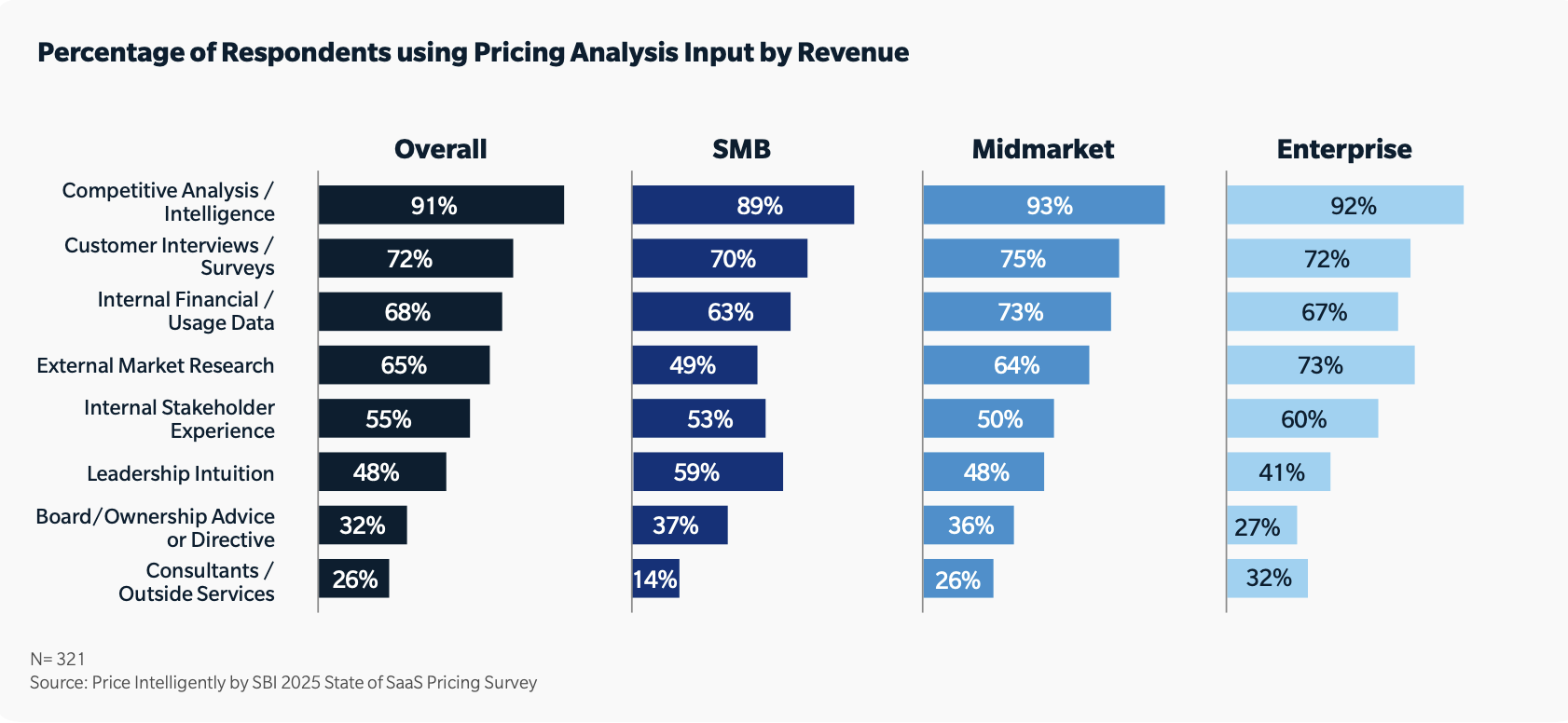
Recommendation: Before leaning into costly external market research, first analyze usage patterns and financial/churn data to understand customer behavior and pricing efficacy. Then, test pricing changes with accounts that have clean upgrade histories, multi-product adoption, and strategic engagement.
2. Start Experimenting with Usage-Based Pricing
No SaaS pricing model consistently outperforms the rest, but usage-based models that align with customer value are increasingly popular (24% of horizontal SaaS solutions use them) and effective (these companies are 68% more likely to meet or exceed their growth targets).
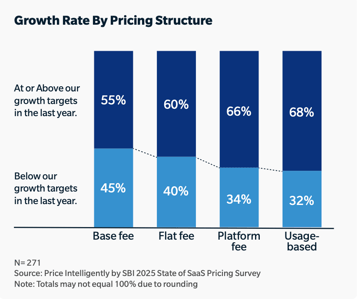
Seats still drive more than 80% of pricing across all models, but only 7% of companies use seats as the only value metric that drives pricing with value-based alternatives no longer just a revenue opportunity - but a growth imperative.
Recommendation: Join the fifth of SaaS companies already employing usage-based pricing elements. In particular, experiment with usage metrics that align with customer value.
3. Adopt a Pricing Strategy That Matches Your Company Reality
Successful SaaS companies package their product(s) according to their execution capabilities - not customer demand or company ambitions.
For example, SMBs with strained resources thrive with simpler all-in-one packaging where every customer gets identical features, whereas enterprises are more adept at handling complex packaging with multiple add-ons. Meanwhile, sales-led growth (SLG) companies are more likely to offer complex add-ons (which sales teams can explain) than product-led growth (PLG) companies, which need simpler, more self-explanatory offerings.
- SMBs are 3x more likely to use all-in-one packaging than larger companies (21% vs. ~7%).
- Enterprises are nearly 10x more likely than SMBs to offer 6+ add-ons (39% vs 4%).
- 60% of SLG companies offer 3+ add-ons compared to just 35% of PLG companies.
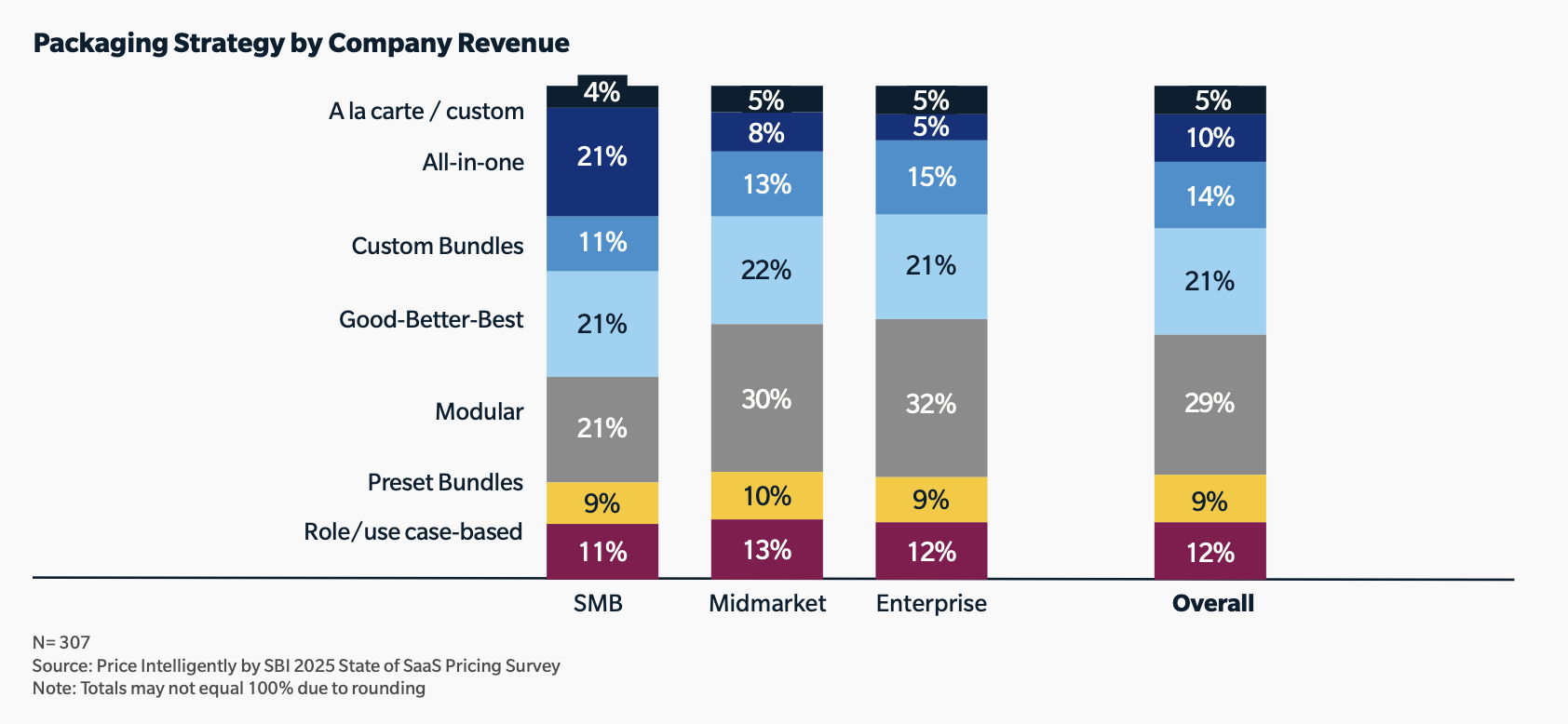
Recommendation: Match packaging complexity to your GTM motion and resources (i.e. your team’s ability to execute, sell, and support it).
4. Take a Strategic & Localized Approach to Price Increases
Mature SaaS companies develop systematic approaches to price increases instead of relying on intuition. 55% of enterprises increase prices annually or at contract renewal, whereas SMBs are twice as likely to raise their prices ad-hoc than mid-market or enterprise companies (28% vs. 14%).
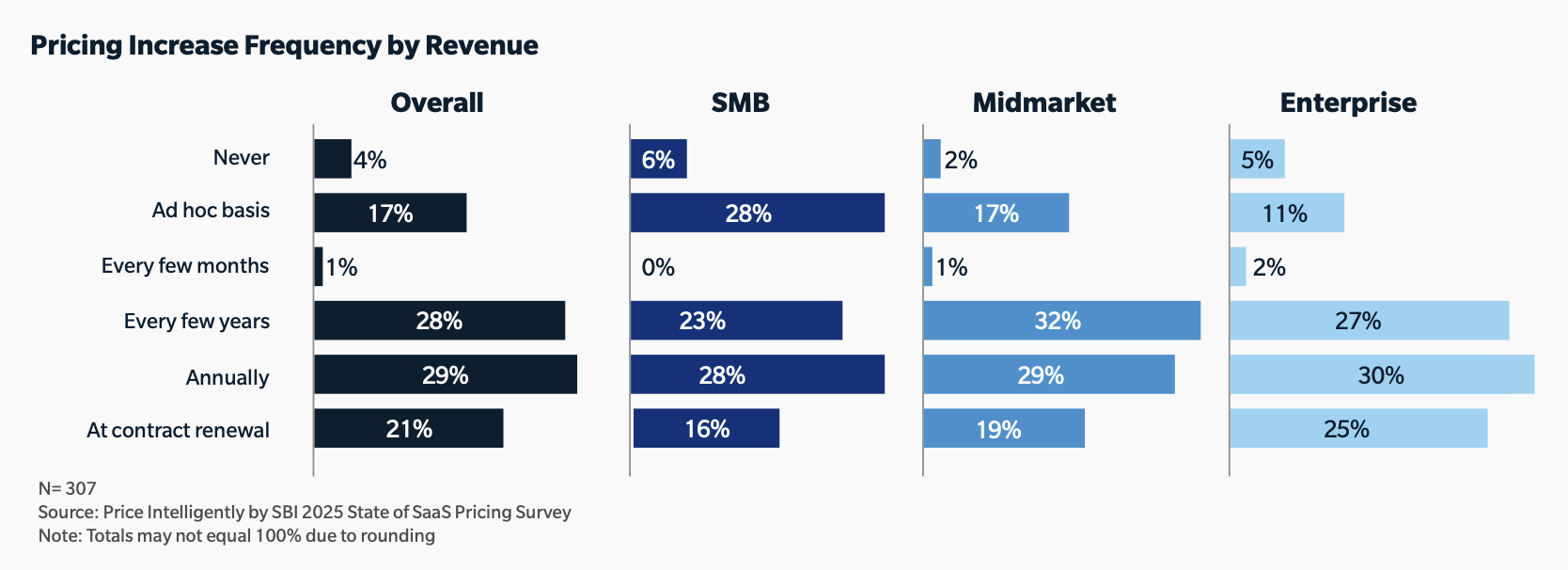
In addition, 52% of companies make international price adjustments, but only 24% of SaaS companies localize their pricing based on willingness to pay. Advanced localization (i.e. changing packaging and pricing models to match local market dynamics) can be resource-heavy, but it’s worth the effort. Companies that don’t localize pricing are more likely to miss their growth targets (45%) than those that do (29%).
Recommendation: Replace ad-hoc pricing decisions with systematic annual reviews and invest in modern billing systems that automatically enable pricing localization.
5. Align Pricing Transparency to Customer Acquisition
Should you publish your pricing? It depends on how your customers actually buy from you and the customers you’re targeting.
If you’re a PLG company, published pricing acts as a conversion tool, helping customers compare with other solutions and onboard themselves. If you have a SLG motion, hiding your pricing gives your sales team flexibility to optimize pricing during sales conversations.
That’s why PLG companies are nearly 3x more likely to publish pricing information and 4.6x more likely to show complete pricing details than SLG companies.
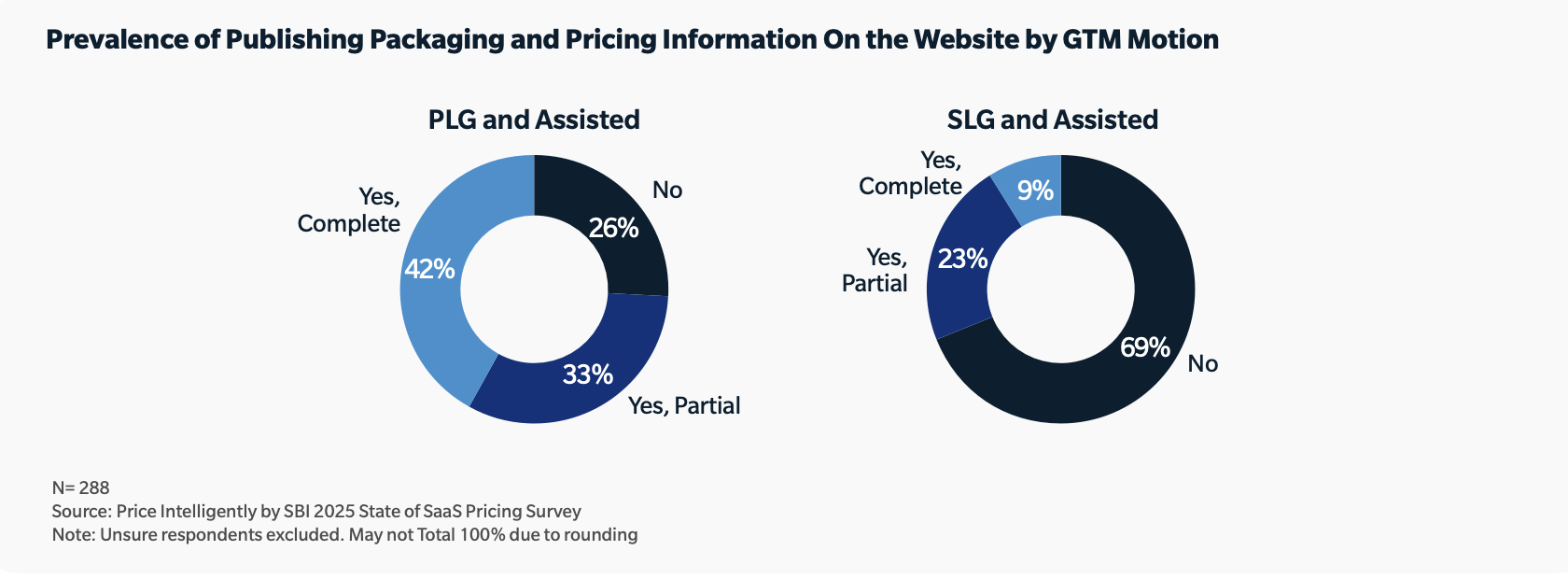
Meanwhile, companies targeting smaller businesses are significantly more likely to publish pricing (59% vs 35% for enterprise-focused companies) as smaller buyers need upfront pricing to make quick purchasing decisions.
Recommendation: If you’re PLG, embrace pricing transparency. If you’re SLG, consider partial transparency (showing packaging without specific prices) to build trust while preserving sales conversation value.
6. Build Pricing Operations to Control Discounting
For obvious revenue reasons, discounting should be avoided where possible. Building pricing operations prevents you from ceding to pressure from prospects and sales teams.
For instance, you should:
- Set up a deal desk. Companies with deal desks handling specific products or customer segments are 20-30% more likely to hit growth targets. But 62% of SMBs don’t have deal desks compared to 26% mid-market and 11% of enterprises.
- Discount according to your solution. Horizontal solutions that face more feature competition discount more heavily than vertical solutions that solve industry-specific problems (23% vs 2% give 26%+ off list price).
- Employ strict approval processes. Strict approval processes are more than twice as likely than flexible guidelines to keep discounts under 10% (48% vs. 22%).
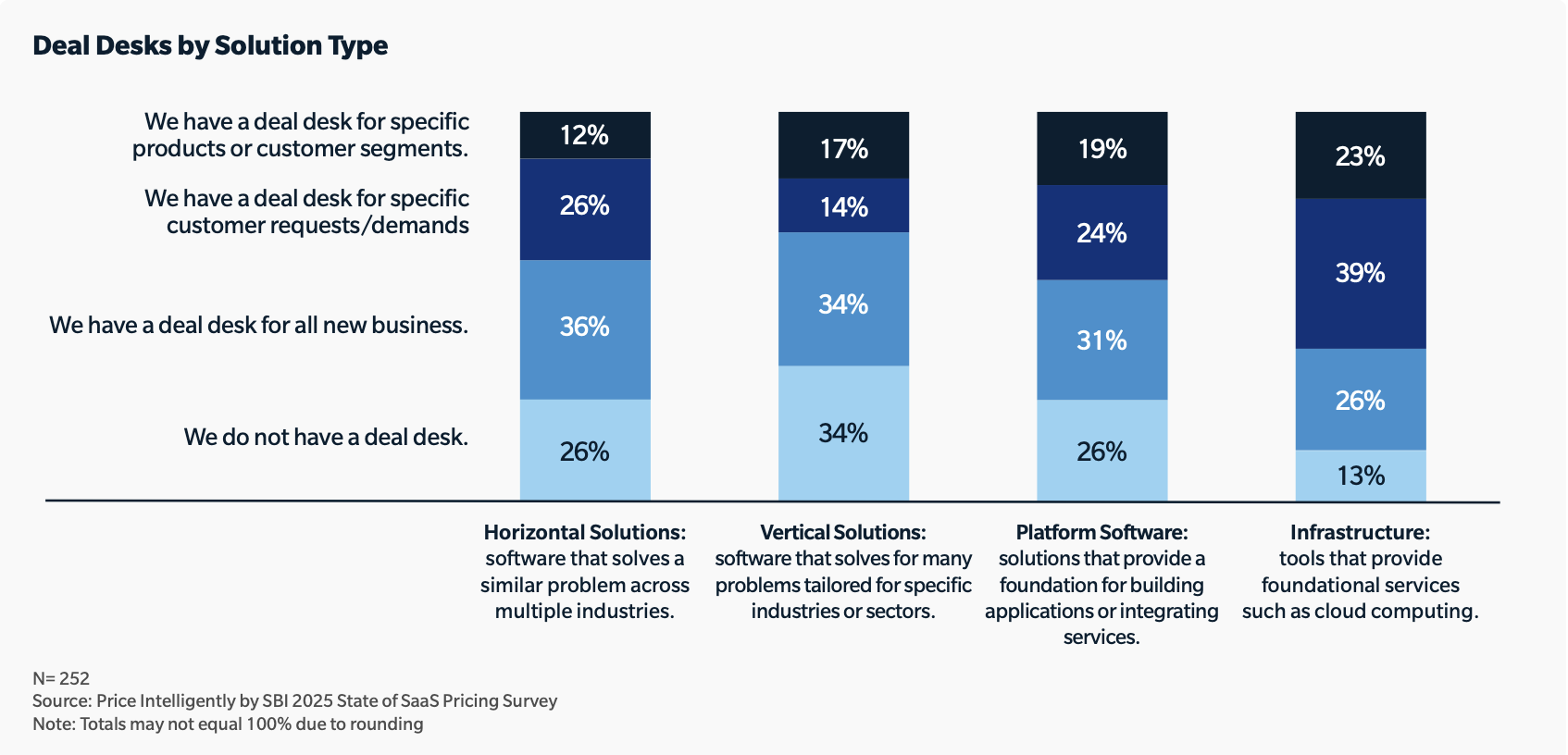
Recommendation: Set up strict approval processes to limit discounting immediately (one-third of companies with strict processes operate without deal desks). Then, build deal desk infrastructure based on solution complexity, not company size.
Use SaaS Pricing Benchmarks to Get Ahead of the Curve
Pricing data beats gut instinct everytime. By pinpointing where you stand and identifying opportunities for improvement, you can build a systematic, data-informed pricing strategy that rocket-boosts growth.
For deeper insights and recommendations, download: 2025 State of SaaS Pricing Report Part 2: Benchmarks to Help Pricing Leaders Move Beyond Intuition-Based Decisions
For more insights on revamping your pricing, download: 2025 State of SaaS Pricing Report Part 1: 10 Insights for Building Market-Leading Pricing
/pexels-olia-danilevich-8145242.jpg)
/pexels-olia-danilevich-8145242.jpg)